Berta Tilmantaitė
Stories help us make sense of the present moment

A conversation about storytelling with multimedia journalist Berta Tilmantaitė
The image was unforgettable: Olympic champion Rūta Meilutytė swimming through a pond dyed blood-red, in front of the Russian Embassy in Vilnius. The photos rippled across the world.
The performance, Swimming Through, aimed to draw attention to the war in Ukraine — and, perhaps just as urgently, to speak to our own experiences as onlookers, watching from the fragile comfort of distance.
“After Russia launched its invasion on February 24, we all went through some kind of internal shift. We tried to help Ukraine in every way we could. But people grow weary — of information, of emotions. We wanted to keep the conversation alive, to keep pressure on politicians and decision-makers,” explains Berta Tilmantaitė, one of the creators of the piece, multimedia journalist, photographer, co-founder of Nara.lt, and keynote speaker at @Shibui.
“The performance emerged from a genuine need to express what we were feeling — to speak about what matters.”
Art as collective memory and mirror
“It all unfolded naturally,” Berta recalls, “through conversations with Rūta, with Neringa Rekašiūtė, Aurelija Urbonavičiūtė.
Both art and journalism are, at their core, about storytelling — about weaving threads that bind us together. From the feedback we received, it was clear the performance had landed: it spoke to how we felt, it articulated what we wanted to say, and it resonated with people around the world.”
In times of turmoil, people instinctively turn to art. It helps us orient ourselves, fosters connection, creates a sense of shared meaning.
“What’s happening in Ukraine, what we’re living through — it’s not unprecedented. History has seen this before. Through stories, we tap into archetypes, we find echoes, we root ourselves. Art gives shape to those experiences, lends them form, tells the story of what’s unfolding — and so it becomes the language we need. Or sometimes, it reminds us when to stay silent.”
Berta is convinced: shared stories, symbols, archetypes build solidarity. They help us endure.
Storytelling as a team-strengthening tool
What holds true at a societal scale can be just as potent inside organisations.
“In many workplaces, people don’t communicate openly — especially after the isolation of the pandemic, with meetings reduced to Zoom check-ins on tasks. And war, layered on top, has only deepened the disconnection.
Art, journalism, and the emotional terrain they explore can help teams come closer, connect, find common ground — even across differing reactions.”
Berta draws on her own past experiences: watching art together, listening to stories, reflecting as a group, sharing responses — these become simple but profound ways to build stronger teams, to help colleagues understand one another, and ultimately, to fortify resilience.
“And you can go further,” she adds. “Not just discussing art or stories, but daring to create yourselves.”
Such experiences, Berta says, often surprise people — and expand them. “They push the edges of who we think we are. They help us grow, strengthen, become more resilient. Because to withstand life’s shocks, we first have to understand what’s happening — and what we can do with it.”
If you want to explore the power of storytelling and collective meaning, bring Berta in as a keynote speaker with her session “Stories That Move Us” at @Shibui.
